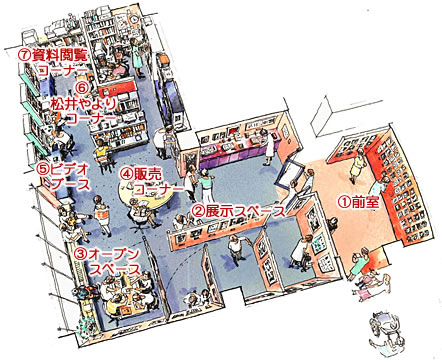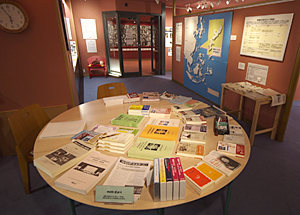Floor Map

(1)Survivor’s Portraits
(2)Exhibition Space
(3)Open Space
(4)Reception Desk
(5)Video Booth
(6)Yayori Corner
(7)Library
(1)Survivor’s Portraits
 As you enter, the pictures of the women victims of the Japanese Military Sexual Violence welcome you. They are over 150 women (as March, 2008) who gave us their permission to share their pictures, names and the experiences with people who visit the WAM. Be sure to look at the chronology of the history of “Comfort Women” before, during and after the War.
As you enter, the pictures of the women victims of the Japanese Military Sexual Violence welcome you. They are over 150 women (as March, 2008) who gave us their permission to share their pictures, names and the experiences with people who visit the WAM. Be sure to look at the chronology of the history of “Comfort Women” before, during and after the War.
(2)Exhibition Space
 One or Two Special Exhibitions are held every year with the topics related to the “Comfort Women” issue. The regular exhibition includes panels on the Women’s International War Crimes Tribunal held in 2000 and a map of the “Comfort Stations” all over Asia.
One or Two Special Exhibitions are held every year with the topics related to the “Comfort Women” issue. The regular exhibition includes panels on the Women’s International War Crimes Tribunal held in 2000 and a map of the “Comfort Stations” all over Asia.
(3)Open Space
 A quiet space where you can relax and enjoy the view of a red brick Church through the spacious window.
A quiet space where you can relax and enjoy the view of a red brick Church through the spacious window.
(4)Reception Desk
 You can purchase books published by NGOs and Support organizations of the “Comfort Women” which you don’t find in ordinary bookstores.
You can purchase books published by NGOs and Support organizations of the “Comfort Women” which you don’t find in ordinary bookstores.
(5)Video Booth
 You can watch videos of the Testimonies of the “Comfort Women”, the entire record of the Women’s International War Crimes Tribunal, videos produced by NGOs and other valuable audio-visual materials. You can also watch the videos of the seminars and symposium organized by the WAM.
You can watch videos of the Testimonies of the “Comfort Women”, the entire record of the Women’s International War Crimes Tribunal, videos produced by NGOs and other valuable audio-visual materials. You can also watch the videos of the seminars and symposium organized by the WAM.
(6)Yayori Corner
 Matsui Yayori who organized the Women’s International War Crimes Tribunal and envisioned the WAM was a prominent editorial staff of Asahi Newspaper and feminist activist. Yayori Corner provides you with all of her books and articles.
Matsui Yayori who organized the Women’s International War Crimes Tribunal and envisioned the WAM was a prominent editorial staff of Asahi Newspaper and feminist activist. Yayori Corner provides you with all of her books and articles.
There are also her desk and computer exhibited.
(7)Library
 The WAM is the only place in Japan where you can have access to the information/material on the Women’s International War Crimes Tribunal and the “Comfort Women” trials against Japanese Government. There are books, magazines, theses, material related to the military, records of activities by support groups, small publications, bulletins and records of the NHK trial.
The WAM is the only place in Japan where you can have access to the information/material on the Women’s International War Crimes Tribunal and the “Comfort Women” trials against Japanese Government. There are books, magazines, theses, material related to the military, records of activities by support groups, small publications, bulletins and records of the NHK trial.
